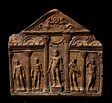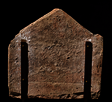Terracotta relief, a palaestra
Summary
The relief depicts five statues in an architectural setting: a porticus with six fluted Corinthian columns, the bases of which are shaped as a double torus. The two columns in the centre are bigger than the others, and a wreath of leaves is hanging between the two capitals.
Description of object
These columns in the centre are bigger than the others, and a wreath of leaves is hanging between the two capitals. These columns support a triangular pediment with a depiction in relief of two snake-like sea creatures with human torsos (so-called hippocamps) holding a circular shield. The pediment extends for some length to the left and right of the two supporting columns, so we are obviously not dealing with a naturalistic depiction of a building.
A frontal statue of Hercules,the roman counterpart to the Greek hero Herakles, stands on a low basin in the central intercolumnium. He is shown as standing, nude, and is easily recognizable by his attributes: the lion skin above the left forearm and the club in his right hand. Hercules wears a full beard, and on each side of his head the ends of a ribbon are hanging down. The statue is a copy of a Greek type, the so-called Chiaramonti Herakles, which is thought to have been made in the 4th century B.C. The type is relatively rare in Roman art, and it is possible that a Hellenic replica – perhaps the original itself – stood in one of the numerous Herakles temples in Rome.
A porticus with four columns supporting a plain frieze and an architrave is seen at a level behind (?) the two central columns adorned with horizontal lines. A decorative frieze with arches and small palmettes crowns the slanting roof tile. Statues of athletes are standing on low bases in the four intercolumnia. To the left two pugilists with leather thongs, which functioned as a kind of boxing glove, wrapped around their forearms. An athlete scraping oil off on his body is seen to the right and a victor crowning himself with his right hand and holding a palm leaf in his left.
The scene depicts a palestra, an open courtyard surrounded by portici, where athletes did her training. The presence of Hercules is explained by the fact that he was the legendary founder of the Olympic games and he was worshipped in the gymnasia and palestrae from the Classical period onwards. The central part of the relief may be regarded as a rendering of a Hercules temple or as an exedra (a semi-circular niche) in the porticus.
Other relief plaques with the same motif as this one have been found in the gardens of Sallustius in Rome, and presumably made in the same mould. They probably all come from the same building, perhaps a palestra connected to a bath complex. The area was a large pleasure garden in the north-eastern outskirts of Rome, founded by the historian Caius Sallustius Crispus (86 – 35 B.C.) The gardens later became Imperial property and continued to be so, until the Goths took Rome in A.D. 410.
Choice of methods
Visual examination
- Macroscopic
Technical imaging
- UV
- VIL
- IR
Sampling
- XRF
- FT-IR
- Raman
Bibliography
V. Poulsen, 1949, no. 104
LIMC IV (1988) 752-753, s.v. Herakles (O. Palagia)
For a parallel to 183 in Vienna, see ibid. 752, no. 452.
Identification of the temple of Hercules: M.T. Marabibi Moevs, BdA 66, 12, s. VI (1981) 47-48.
Variant of catalogue no. 183: C.C. Vermeule, BMFA 65 (1967) 180-181, fig. 6; see also B.
Hedinger, AntK 30 (1987) 77 and Strazzulla 1987, 184-186;
LIMC IV (1988) 796-797, s.v. Herakles (J. Boardman).
Gardens of Sallustius: Moltesen 1987, 126-132.
- IN 1929
- Relief
- c. 50 B.C.-60 A.D.
- Roman Republican
- Terracotta
- Acquired in Rome in 1899.
- H: 39 cm; L: 39.5cm

